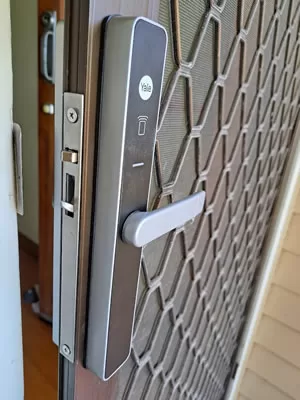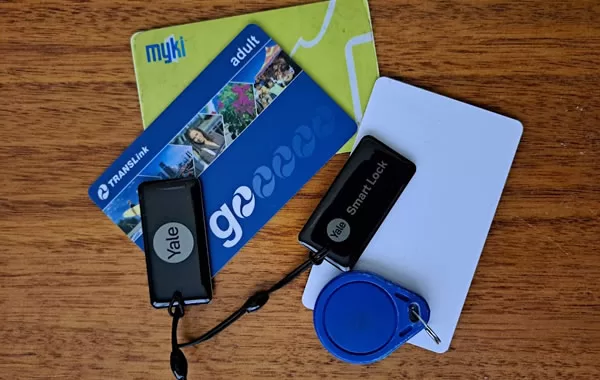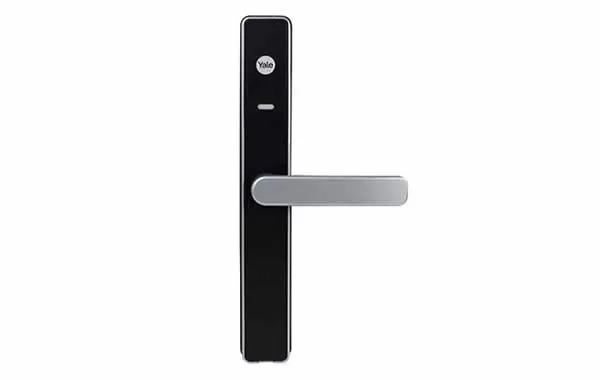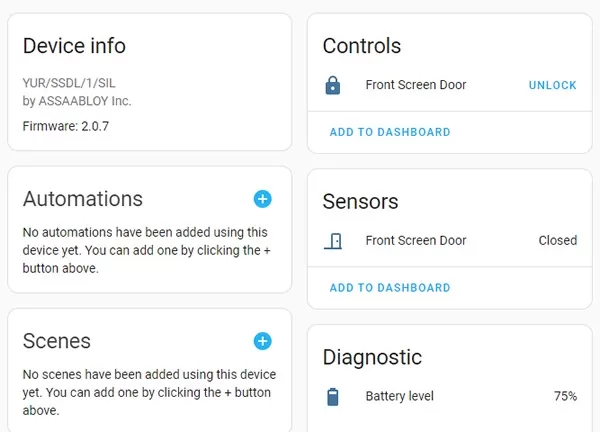I recently needed to use up some Bunnings gift cards, so I decided to splurge on a smart lock to help beef up my home security. What I ended up buying was Yale’s Unity screen door lock, this lock is designed to retrofit in place of the standard screen door lock like I have had installed at my house since the 1980s.
What is it
Powered by four AA batteries, Yale’s Unity series of smart locks connect via Bluetooth directly to either their app on your android or iOS phone or via their optional hub that connects the lock to Wi-Fi for remote access and also control from Google Home, Alexa and Smart Things. At $398 AU the Unity screen door lock is not cheap but on par with other smart locks on the market. Their Connect Bridge and Connect Plus bridge are listed as $166 AU and $149 AU respectively. This review will deal with the lock only, as I believe the bridge is a bit too pricey, and I think can do without it.
Normally I would prefer a Zigbee connected device over Bluetooth, but this lock was the only form factor that was a direct replacement for my existing dumb lock without modifying or changing the door. It’s worth noting that Yale also sells the Assure range of locks that have the option of Zigbee or Z-Wave plug in modules. While a fantastic idea, these modules are not compatible with the Unity series of locks. My guess is that the Unity series is tech that Yale inherited via their purchase of August Home in 2017, hence why they have two different product lines in the smart lock space. The Yale Unity lock can be controlled via the Yale app or the very similar August app.
Installation
Install of the Unity lock was pretty straight forward and much like the installation of a standard dumb lock on a screen door. The main difference between the Unity and dumb lock install is the cable that runs through from the outer handle to the inner handle. Another cable also runs between the mortice lock and the inner handle, this has to be fished out of the mortice lock once it is in place on the door. Both cables have rather small plugs on them that plug onto the inner handle circuit board, while I am familiar with these type of cables, I think someone with bad eyesight or sausage fingers may find these cables a bit fiddly. The final assembly of the lock involves two screws that live under the upper and lower battery compartment that pass through to the outer lock. While the lock can be installed by one person, a second pair of hands would be a help during final assemble. The other piece of major hardware supplied in the kit is the striker plate that goes onto the door frame. I found that I didn’t need to use this as my previous dumb lock plate was near identical and worked with the lock as is, which is testament to what a great retrofit this smart lock is to an old security door.

Setup and Usage
Setup of the Unity lock is fairly straightforward and both the Android and iOS apps are very similar, with the latter also having a HomeKit option (more on that later).
Once you create an account and do a 2FA confirmation with both your email and phone number, you can go about adopting the lock into your account. I found that the app was very fussy about being right next to the lock when setting it up or adjusting settings.
When you open the lock status in the app you are presented with a big round circle indicating if the door is locked, unlocked or open. This can be slow to respond on the first opening of the app, as your phone’s Bluetooth connects to the lock. I assume this would not be an issue if using the Yale bridge. On the settings side, you can set an auto lock settings after a preset time and also an auto unlock feature that uses your phone’s GPS to determine that you have arrived home. You can also program RFID tags to unlock the lock, two of which are included in the Unity box. I have also found generic RFID tags can also be programmed to the lock, some of the ones I tested were cheap generic tags from eBay as well as an old public transport smart card. Depending on what system your local public transport system uses, your mileage may vary on using on your local card.

On the automation side of the app, the options are pretty basic, with an auto lock and unlock option. The auto unlock feature uses phone location to determine if you are near home, and the door will unlock as soon as you get home. In practice this has worked flawlessly, as soon as I am near the lock the door will unlock, so I assume some Bluetooth detection is being used too.
Homekit Setup
While I use an Android phone as my daily phone, I do often use an iPad and an AppleTV, with the AppleTV being in close proximity to my lock, so I decided to add it to HomeKit. Doing so was straight forward like any other HomeKit accessory and once the QR code below the battery case or on the box was scanned, the lock was connected to Apple’s Home app. From here you set up a few more complex automations than what the native Yale app gives you, and there is no need to be standing right next to the lock to adjust settings. If you are in the Apple ecosystem and have an AppleTV near your lock, HomeKit makes for a fantastic alternative to purchasing the Yale connect bridge.
Using with Home Assistant
Regular readers of this blog will know I am a big fan of Home Assistant, so naturally I would want to hook this lock up to Home Assistant. Unfortunately, I have failed on this step, and not without a lack of trying. To do so I set up a Bluetooth proxy that saw the lock but the requirements to find the software keys generated by the lock were impossible to get without a rooted Android phone, I also tried the HomeKit controller and August Cloud method and eventually got to the point where Home Assistant does not see the lock anymore. So I have given up on connecting the lock to Home Assistant. If Yale ever upgraded their hub to support Matter or Home Assistant directly, then I may consider purchasing their hub.
Wrap Up
Despite the shortcomings of no easy Home Assistant connection, I am happy with the Yale Unity Lock, It was easy to install, it works ok stand alone, and I can create a few more advanced automations via HomeKit. I believe the lock works fine without their connect hub but if you wanted to control it or multiple locks via Google Home, Alexa or Smart Things than the purchase of the Hub would be necessary. At this stage, I am reluctant to purchase. Yale’s website is confusing as there are two hub models available and no real difference between them mentioned on their website. Will one or both of these be upgraded to Matter or will there be a third hub released, also will any of the two existing hubs be made obsolete? I am prepared to wait and see if the connect hub improves in the coming year before investing further in the lock.
It was unfortunate that I had so much difficulty in getting it connected to Home Assistant, your millage may vary, and I suspect it may work better in other regions like the USA where Yale’s partner brand August exists. Hopefully one day, connections to Home Assistant will be a lot easier than they are now.
Update 11/5/23
I finally have the Yale screen door lock working with Home Assistant via my ESPHome Bluetooth proxy. I would like to explain how, but in reality I am not sure how it started working. Shortly after posting this article the lock was seen again by Home Assistant, but to set up it required the offline keys as mentioned in Home Assistant’s docs about the lock. I never got around to rooting an android phone to get the keys, but I have been using the August version of the app as well as the August cloud integration in Home Assistant. Randomly when restarting Home Assistant after an update I would check if the keys have been pulled from Home Assistant’s August integration. Today, almost 2 months after I first set it up and mostly forgot about it, clicking on the discovered device again resulted in it letting me add the lock to Home Assistant without entering a key. Interestingly, I also received an email today advising about a new Yale app experience is coming soon. Was this related or a coincidence, or am I in for more pain soon? At the moment, I am just happy to put some successful closure on my attempt to connect the Yale screen door lock to Home Assistant without buying the Yale bridge.
Update 19/5/23
Yale have released their new app and keen to get me to upgrade, judging by their emails. I have not done so as I was concerned about Home Assistant access. Today I got this warning in Home Assistant below.
Yale Home app migration
Summary
Yale is migrating some Yale Access users outside North America to a new Yale Home app. If you use the August integration or Yale Access Cloud integration, migrating your account to Yale Home will prevent the integration from accessing your account.
Links

